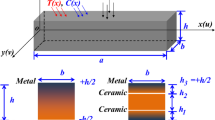Abstract
Distribution and level of self-stress has a profound impact on the structural behavior of tensegrity systems. The problems associated with self-stress implementation preclude designing tensegrity structures for civil engineering application. To achieve the feasible self-stress state of a tensegrity shell structure, an efficient procedure based on solving an optimization problem in conjunction with multi constraint equations on group subdivisions is presented in the current study. Several tensegrity shell configurations are utilized to demonstrate the capability of the proposed procedure. The method provides superior performance compared with the other conventional methods of obtaining desired self-stress distributions. For a given shell configuration, group division is of paramount importance with respect to the regularity and uniformity of self-stress distributions.




















Similar content being viewed by others
References
Tang Y, Yin J (2017) Design of cut unit geometry in hierarchical kirigami-based auxetic metamaterials for high stretchability and compressibility. Extrem Mech Lett 12:77–85. https://doi.org/10.1016/j.eml.2016.07.005
Bertoldi K, Vitelli V, Christensen J, Van Hecke M (2017) Flexible mechanical metamaterials. Nat Rev Mater 2:17066. https://doi.org/10.1038/natrevmats.2017.66
Skelton RE, De Oliveira MC (2009) Tensegrity systems. Springer, New York. https://doi.org/10.1007/978-0-387-74242-7
Wang BB (2004) Free-standing tension structures: from tensegrity systems to cable-strut systems. Spon Press
Liew JYR, Lee BH, Wang BB (2003) Innovative use of star prism (SP) and di-pyramid (DP) for spatial structures. J Constr Steel Res 59:335–357. https://doi.org/10.1016/S0143-974X(02)00037-8
Pellegrino S (1992) A class of tensegrity domes. Int J Sp Struct 7:127–142. https://doi.org/10.1177/026635119200700206
Kmet S, Mojdis M (2013) Time-dependent analysis of cable domes using a modified dynamic relaxation method and creep theory. Comput Struct 125:11–22. https://doi.org/10.1016/j.compstruc.2013.04.019
Fraternali F, Carpentieri G, Amendola A (2015) On the mechanical modeling of the extreme softening/stiffening response of axially loaded tensegrity prisms. J Mech Phys Solids 74:136–157. https://doi.org/10.1016/j.jmps.2014.10.010
Zhang J, Ohsaki M (2005) Form-finding of self-stressed structures by an extended force density method. J Int Assoc Shell Spat Struct 46:159–166
Connelly R, Terrell M (1995) Globally rigid symmetric tensegrities tensegrites symetriques globalement rigides. Struct Topol 21:59–78
Vassart N, Motro R (1999) Multiparametered formfinding method: application to tensegrity systems. Int J Sp Struct 14:147–154. https://doi.org/10.1260/0266351991494768
Sultan C, CorlessM, Skelton RE (1999) Reduced prestressability conditions for tensegrity structures. In: Proceedings of 40th ASME structure dynamic material conference, pp 2300–2308
Quirant J, Kazi-Aoual MN, Laporte R (2003) Tensegrity systems: the application of linear programmation in search of compatible selfstress states. J Int Assoc Shell Spatial Struct 44:33–50. http://cat.inist.fr/?aModele=afficheN&cpsidt=14991376
Quirant J (2007) Selfstressed systems comprising elements with unilateral rigidity: selfstress states, mechanisms and tension setting. Int J Sp Struct 22:203–214. https://doi.org/10.1260/026635107783133807
Pellegrino S (1993) Structural computations with the singular value decomposition of the equilibrium matrix. Int J Solids Struct 30:3025–3035. https://doi.org/10.1016/0020-7683(93)90210-X
Yuan X, Dong S (2002) Nonlinear analysis and optimum design of cable domes. Eng Struct 24:965–977. https://doi.org/10.1016/S0141-0296(02)00017-2
Yuan X, Dong S (2003) Integral feasible prestress of cable domes. Comput Struct 81:2111–2119. https://doi.org/10.1016/S0045-7949(03)00254-2
Yuan X, Chen L, Dong S (2007) Prestress design of cable domes with new forms. Int J Solids Struct 44:2773–2782. https://doi.org/10.1016/j.ijsolstr.2006.08.026
Quirant J, Kazi-Aoual MNN, Motro R (2003) Designing tensegrity systems: the case of a double layer grid. Eng Struct 25:1121–1130. https://doi.org/10.1016/S0141-0296(03)00021-X
Tran HC, Lee J (2010) Advanced form-finding of tensegrity structures. Comput Struct 88:237–246. https://doi.org/10.1016/j.compstruc.2009.10.006
Tran HC, Park HS, Lee J (2012) A unique feasible mode of prestress design for cable domes. Finite Elem Anal Des 59:44–54. https://doi.org/10.1016/j.finel.2012.05.004
Hanaor A (1988) Prestressed pin-jointed structures-Flexibility analysis and prestress design. Comput Struct 28:757–769. https://doi.org/10.1016/0045-7949(88)90416-6
Pellegrino S, Calladine CR (1986) Matrix analysis of statically and kinematically indeterminate frameworks. Int J Solids Struct 22:409–428. https://doi.org/10.1016/0020-7683(86)90014-4
Shekastehband B, Abedi K, Dianat N (2013) Experimental and numerical study on the self-stress design of tensegrity systems. Meccanica 48:2367–2389. https://doi.org/10.1007/s11012-013-9754-3
Chen Y, Feng J, Ma R, Zhang Y (2015) Efficient symmetry method for calculating integral prestress modes of statically indeterminate cable-strut structures. J Struct Eng 141:1–11. https://doi.org/10.1061/(ASCE)ST.1943-541X.0001228
Lee S, Lee J (2014) Optimum self-stress design of cable-strut structures using frequency constraints. Int J Mech Sci 89:462–469. https://doi.org/10.1016/j.ijmecsci.2014.10.016
Ma Q, Ohsaki M, Chen Z, Yan X (2018) Step-by-step unbalanced force iteration method for cable-strut structure with irregular shape. Eng Struct 177:331–344. https://doi.org/10.1016/j.engstruct.2018.09.081
Motro R (2003) Tensegrity: structural systems for the future. Kogan Page Sci. https://doi.org/10.1016/B978-1-903996-37-9.X5028-8
S.H. Juan, J.M. Mirats Tur, Tensegrity frameworks: Static analysis review, Mech. Mach. Theory. 43 (2008) 859–881. https://doi.org/10.1016/j.mechmachtheory.2007.06.010
N. Ploskas, N. Samaras, Linear Programming Using MATLAB, 1st ed., Springer International Publishing, 2017. https://doi.org/10.1007/978-3-319-65919-0
Shekastehband B, Abedi K, Dianat N, Chenaghlou MR (2012) Experimental and numerical studies on the collapse behavior of tensegrity systems considering cable rupture and strut collapse with snap-through. Int J Non Linear Mech 47:751–768. https://doi.org/10.1016/j.ijnonlinmec.2012.04.004
Funding
This study received no grant from any funding agency in the public, commercial, or not-for-profit sectors.
Author information
Authors and Affiliations
Corresponding author
Ethics declarations
Conflict of interest
The authors declare that they have no conflict of interest.
Additional information
Publisher's Note
Springer Nature remains neutral with regard to jurisdictional claims in published maps and institutional affiliations.
Rights and permissions
About this article
Cite this article
Mirzaaghazadeh, K., Abedi, K. & Shekastehband, B. An efficient self-stress design of tensegrity shell structures. Meccanica 56, 147–168 (2021). https://doi.org/10.1007/s11012-020-01260-9
Received:
Accepted:
Published:
Issue Date:
DOI: https://doi.org/10.1007/s11012-020-01260-9




